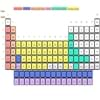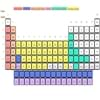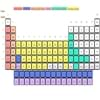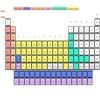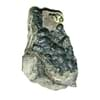Protactinium Tungsten Comparison
Periodic Table
Symbol
Pa
W
Group Number
Not Available
6
12
Period Number
7
6
Block
f block
d block
Element Family
Actinide
Transition Metal
CAS Number
7440133
99+
7440337
99+
Space Group Name
I4/mmm
Im_ 3m
Space Group Number
139.00
8
229.00
1
Facts
Interesting Facts
- Protactinium metal has 29 isotopes.
- Isotopes of Protactinium-231 used in nuclear weapon.
- Tungsten element has the second highest melting point.
- Pure tungsten can easily cut down with the help of hacksaw.
Sources
Found in Uranium Ores, Mining, Ores of metals
Earth's crust, Found in Minerals, Mining, Ores of Minerals
History
Who Discovered
William Crookes
Not Available
Discovery
In 1900
In 1781
Abundance
Abundance In Universe
Not Available
5 * 10-8 %
27
Abundance In Sun
~-9999 %
~0.0000004 %
23
Abundance In Meteorites
Not Available
0.00 %
39
Abundance In Earth's Crust
0.00 %
99+
0.00 %
39
Abundance In Oceans
0.00 %
99+
0.00 %
18
Uses
Uses & Benefits
- Currently known uses of Protactinium metal are limited to research purpose only.
- Tungsten and its alloys are used in high-temperature applications like welding electrodes, high-temperature furnace, etc.
- Tungsten carbide is very hard and used in metal working, mining and petroleum industry.
Industrial Uses
NA
Aerospace Industry, Automobile Industry, Electrical Industry, Electronic Industry
Medical Uses
NA
NA
Other Uses
NA
Alloys
Biological Properties
Toxicity
Highly Toxic
Non Toxic
Present in Human Body
No
Yes
In Blood
0.00 Blood/mg dm-3
37
0.00 Blood/mg dm-3
31
In Bone
0.00 p.p.m.
36
0.00 p.p.m.
35
Physical Properties
Melting Point
1,568.00 °C
21
3,410.00 °C
1
Boiling Point
4,027.00 °C
12
5,660.00 °C
1
Appearance
Physical State
Solid
Solid
Color
Silver
Grayish White
Luster
Metallic
Lustrous
Hardness
Mohs Hardness
Not Available
7.50
2
Brinell Hardness
Not Available
2,000.00 MPa
4
Vickers Hardness
Not Available
3,430.00 MPa
1
Speed of Sound
Not Available
4,620.00 m/s
16
Optical Properties
Reflectivity
Not Available
62.00 %
13
Allotropes
No
No
α Allotropes
Not Available
Not Available
β Allotropes
Not Available
Not Available
γ Allotropes
Not Available
Not Available
Chemical Properties
Chemical Formula
Pa
W
Isotopes
Known Isotopes
27
12
33
6
Electronegativity
Pauling Electronegativity
1.50
27
2.36
2
Sanderson Electronegativity
Not Available
0.98
23
Allred Rochow Electronegativity
1.14
28
1.40
19
Allen Electronegativity
Not Available
1.47
29
Electropositivity
Pauling Electropositivity
2.50
27
1.64
99+
Ionization Energies
1st Energy Level
568.00 kJ/mol
99+
770.00 kJ/mol
16
2nd Energy Level
1,128.00 kJ/mol
99+
1,700.00 kJ/mol
29
3rd Energy Level
1,814.00 kJ/mol
99+
Not Available
4th Energy Level
2,991.00 kJ/mol
99+
Not Available
Electrochemical Equivalent
1.72 g/amp-hr
99+
1.14 g/amp-hr
99+
Electron Work Function
Not Available
4.55 eV
13
Other Chemical Properties
Ionization, Radioactive Isotopes, Radioactivity
Ionization, Radioactive Isotopes, Solubility
Atomic Properties
Atomic Number
91
27
74
99+
Electron Configuration
[Rn] 5f2 6d1 7s2
[Xe] 4f14 5d4 6s2
Crystal Structure
Tetragonal (TETR)
Body Centered Cubic (BCC)
Crystal Lattice
TETR-Crystal-Structure-of-Protactinium.jpg#100
BCC-Crystal-Structure-.jpg#100
Atom
Number of Protons
91
27
74
99+
Number of Neutrons
122
21
110
27
Number of Electrons
91
27
74
99+
Radius of an Atom
Atomic Radius
163.00 pm
25
139.00 pm
39
Covalent Radius
200.00 pm
11
162.00 pm
29
Van der Waals Radius
243.00 pm
11
200.00 pm
28
Atomic Weight
231.04 amu
24
183.84 amu
37
Atomic Volume
15.00 cm3/mol
34
9.53 cm3/mol
99+
Adjacent Atomic Numbers
Valence Electron Potential
92.00 (-eV)
11
140.00 (-eV)
5
Lattice Constant
392.50 pm
23
316.52 pm
99+
Lattice Angles
π/2, π/2, π/2
π/2, π/2, π/2
Lattice C/A Ratio
Not Available
Not Available
Mechanical Properties
Density
Density At Room Temperature
15.37 g/cm3
20
19.25 g/cm3
16
Density When Liquid (at m.p.)
Not Available
17.60 g/cm3
5
Tensile Strength
Not Available
370.00 MPa
10
Viscosity
Not Available
Not Available
Vapor Pressure
Vapor Pressure at 2000 K
Not Available
0.00 (Pa)
32
Elasticity properties
Shear Modulus
Not Available
161.00 GPa
5
Bulk Modulus
Not Available
310.00 GPa
4
Young's Modulus
Not Available
411.00 GPa
4
Poisson Ratio
Not Available
0.28
17
Other Mechanical Properties
Unknown
Ductile, Malleable
Magnetic Properties
Magnetic Characteristics
Specific Gravity
15.37
12
19.22
9
Magnetic Ordering
Paramagnetic
Paramagnetic
Electrical Properties
Electrical Property
Conductor
Superconductor
Resistivity
177.00 nΩ·m
21
52.80 nΩ·m
99+
Electrical Conductivity
0.05 106/cm Ω
34
0.19 106/cm Ω
10
Electron Affinity
Not Available
78.60 kJ/mol
13
Thermal Properties
Specific Heat
0.12 J/(kg K)
40
0.13 J/(kg K)
39
Molar Heat Capacity
Not Available
24.27 J/mol·K
99+
Thermal Conductivity
47.00 W/m·K
32
173.00 W/m·K
7
Critical Temperature
Not Available
Not Available
Thermal Expansion
9.90 µm/(m·K)
40
4.50 µm/(m·K)
99+
Enthalpy
Enthalpy of Vaporization
Not Available
799.10 kJ/mol
1
Enthalpy of Fusion
12.34 kJ/mol
28
35.23 kJ/mol
1
Enthalpy of Atomization
Not Available
837.00 kJ/mol
1
Standard Molar Entropy
198.10 J/mol.K
1
32.60 J/mol.K
99+
|
||
|
||
|


